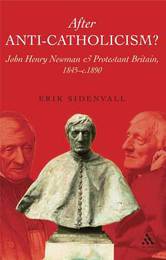
|
After Anti-Catholicism?: John Henry Newman and Protestant Britain, 1845-c. 1890
Hardback
Main Details
| Title |
After Anti-Catholicism?: John Henry Newman and Protestant Britain, 1845-c. 1890
|
| Authors and Contributors |
By (author) Dr. Erik Sidenvall
|
| Physical Properties |
| Format:Hardback | | Pages:222 | | Dimensions(mm): Height 216,Width 138 |
|
| Category/Genre | Roman Catholicism and Roman Catholic churches
Christian theology |
|---|
| ISBN/Barcode |
9780567030764
|
| Classifications | Dewey:280.092 |
|---|
| Audience | | General | | Undergraduate | | Postgraduate, Research & Scholarly | | Professional & Vocational | |
|---|
|
Publishing Details |
| Publisher |
Bloomsbury Publishing PLC
|
| Imprint |
T.& T.Clark Ltd
|
| Publication Date |
10 December 2005 |
| Publication Country |
United Kingdom
|
Description
Is it possible to capture, in brief, the fundamental changes that affected the role of religion within modern Western society? For a long time, many scholars would have answered that question in the positive; most of them would certainly have counted increasingly tolerant attitudes towards forms of religion that were once been regarded as unacceptable, as being one of those central features. In the light of the current revision of the established 'truths' concerning modern religion, it is now possible to once again address the wide-spread belief that modernity meant the gradual victory of more 'liberal' religious attitudes without running the risk of being accused of only dealing with commonplaces. Was modernity only dominated by growing tolerance? And if so, what were the forces that prompted that development? What was the nature of that sentiment? This book approaches these questions by studying the popular Protestant British view of John Henry Newman between the time of his secession 1845 and his death in 1890. It draws on a wide range of sources with a particular focus on the newspaper and periodical press. It argues that changes in popular attitudes were integral parts of the internecine religious disputes of, above all, the 1850s and 1860s. A tolerant discourse came henceforth to live side by side with traditional Protestant rhetoric. Nevertheless, and in spite of expanding horizons, accepting attitudes became an effective vehicle for expressing a sense of Protestant superiority.
Author Biography
Dr Erik Sidenvall is research fellow at the Center for Theology and Religious Studies at Lund University. He has published articles on nineteenth- and twentieth-century European religious history.
Reviews'Erik Sidenvall's book offers a new and intriguing perspective on Victorian religion, the role of anti-Catholicism, and the rise of toleration within English society...Erik Sidenvall's book is an important addition to Newman scholarship and British religious history. His insights into public opinion, the issue of religious conversion, and the relationship of prejudice and toleration are important elements in appreciating the dynamics of Victorian religion and the challenges of today's world where bigotry and intolerance still exist.' Rene Kollar, Saint Vincent Archabbey, Latrobe, PA, Heythrop Journal -- Rene Kollar, Saint Vincent Archabbey, Latrobe, PA, Heythrop Journal, XLVIII (2007) * Heythrop Journal * 'Religious controversy was practically a staple of Victorian life. This study, originally a doctoral dissertation at the University of Lund (Sweden), investigates the emergence of religious tolerance in nineteenth-century Britain by examining the public reaction to pivotal events in the life of John Henry Newman (1801-90). Although Newman was no stranger to controversy during his Anglican years, his "secession" from the Church of England to Roman Catholicism in 1845 unleashed a tidal wave of anti-Catholicism. Two decades later, in contrast, the publication of his Apologia pro vita sua (1864) evoked more tolerant and less prejudicial attitudes. By the time of his death (1890), the "great apostate" of 1845 was regarded in many circles as "the revered lion of culture and sublime religious sentiment." In the author's historical analysis, this shift in attitudes was certainly not universal but represents a complex, even sometimes contradictory political- social symbiosis of an expanding religious tolerance with a still deep-seated and thus far from defunct anti-Catholicism. Even though some may have reservations about Sidenval's main thesis about the dynamics and dimensions of Victorian toleration, readers will benefit greatly from this book's detailed information and numerous insights based on extensive research into primary sources, particularly Victorian periodicals. This book, written in clear, crisp, and cogent prose, is a "must read" for all those interested in Victorian religious history, especially Newmanists.' John T. Ford The Catholic University of America * Religious Studies Review *
|